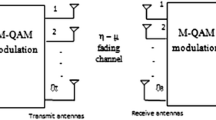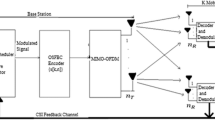Abstract
In this paper, we consider a multiple-input-multiple-output system employing orthogonal space time block codes over a generalized fading model, namely, \(\eta - \mu\) fading distribution. Simplified closed-form expressions for the probability density function and cumulative distribution function of the proposed system under absolute SNR scheduling have been derived in this paper. More specifically, new analytical expressions for average bit error rate and average channel capacity are derived for two cases: (a) independent and identically distributed (i.i.d) fading links and (b) independent and non-identically distributed (i.ni.d) fading links. Numerical evaluation shows improvement in system performance for various values of \(\eta\) in format 1 with increase in the (a) number of users (U), (b) number of transmit antennas (n T ), and (c) number of receive antennas (n R ). The proposed mathematical analysis is verified using MATLAB numerical results which demonstrate the accuracy of theoretical approach.








Similar content being viewed by others
References
Alamouti, S. (1998). A simple transmit diversity technique for wireless communications. IEEE Transactions on Communications, 16(8), 1451–1458.
Gesbert, D., Shafi, M., Shiu, D. S., Smith, P., & Naguib, A. (2003). From theory to practice: An overview of MIMO space-time coded wireless systems. IEEE Journal on Selected Areas of Communication: Special Issue on MIMO Systems, Part I, 21, 281–302.
Tarokh, V., Jafarkhani, H., & Calderbank, A. R. (1999). Space-time block codes for orthogonal designs. IEEE Transactions on Information Theory, 45(5), 1456–1467.
Kansal, L., Kansal, A., & Singh, K. (2011). BER analysis of MIMO-OFDM system using OSTBC code structure for M-PSK under different fading channels. International Journal of Scientific and Engineering Research, 2(11), 1–12.
Yacoub, M. D. (2007). The κ − μ distribution and the η − μ distribution. IEEE Antenna Propagation Magazine, 49(1), 68–81.
da Costa, D. B., Filho, J. C. S. S., Yacoub, M. D., & Fraidenraich, G. (2008). Second-order statistics of η − μ fading channels: Theory and applications. IEEE Transactions on Wireless Communications, 7(3), 819–824.
Peppas, K. P. (2010). Capacity of η − μ fading channels under different adaptive transmission techniques. IET Communications, 4(5), 532–539.
Peppas, K. P., Lazarakis, F., Zervos, T., Alexandridis, A., & Dangakis, K. (2010). Sum of non-identical independent squared η − μ variates and applications in the performance analysis of DS-CDMA systems. IEEE Transactions on Wireless Communications, 9(9), 2718–2723.
Yu, H., Wei, G., Ji, F., & Zhang, X. (2011). On the error probability of cross-QAM with MRC reception over generalized η − μ fading channels. IEEE Transactions on Vehicular Technology, 60(6), 2631–2643.
Peppas, K. P., Alexandropoulos, G. C., & Mathiopoulos, P. T. (2013). Performance analysis of dual-hop AF relaying systems over mixed η − μ and k − μ fading channels. IEEE Transactions on Vehicular Technology, 62(7), 3149–3163.
Morales-Jimenez, D., & Paris, J. F. (2010). Outage probability analysis for η – μ fading channels. IEEE Communication Letters, 14(6), 521–523.
Mark, J. O., Samir, B. B., & Saad, N. M. (2013). Capacity and error probability performance analysis for MIMO MC-DS CDMA system in η − μ fading environment. International Journal of Electronics and Communications, 67(4), 269–281.
Ajib, W., & Haccoun, D. (2005). An overview of scheduling algorithms in MIMO-based fourth-generation wireless systems. IEEE Network, 5(19), 43–48.
Realp, M., & Perez-Neira, A. (2006). Generalized model for scheduling in MIMO multiple access systems: A cross-layer approach. Signal Processing, 86(8), 1834–1847.
Vicario, J., & Anton-Haro, C. (2006). Spatial vs. multiuser diversity trade-offs for cross-layer scheduling in limited feedback systems. Signal Processing, 86(8), 1848–1863.
Chang, Y., & Araki., K. (2012). Proportionally fair user scheduling for multiuser MIMO systems with unequal average SNR users. In 75th IEEE conference on vehicular technology, Yokohama, Japan, pp. 1–5.
Gaaloul, F., Radaydeh, R. M., Alouini, M. S., & Yang, H. C. (2012). On the performance of multiuser scheduling with post-examining under non-identical fading. In IEEE conference on wireless communications and networking, Shanghai, China, pp. 1251–1256.
Torabi, M., Haccoun, D., & Ajib, W. (2011). On the capacity and BER performance of multiuser scheduling over MIMO Nakagami-m fading channels. Signal Processing, 91(11), 2487–2496.
Yacoub, M. D. (2007). The κ − μ distribution and the η − μ distribution. IEEE Antennas and Propagation Magazine, 49(1), 68–81.
Gradshteyn, I. S., & Ryzhik, I. M. (2007). Table of integrals, series and products (7th ed.). California: Academic Press.
David, H. A., & Nagaraja, H. N. (2003). Order statistics (3rd ed.). Hoboken: Wiley.
da Costa, D. B., & Yacoub, M. D. (2007). Average channel capacity for generalized fading scenarios. IEEE Communication Letters, 11(12), 949–951.
Efthymoglou, G. P., Ermolova, N. Y., & Aalo, V. A. (2010). Channel capacity and average error rates in generalized-K fading channels. IET Communications, 4(11), 1364–1372.
Zhang, Q. T. (2003). A generic correlated Nakagami fading model for wireless communications. IEEE Transactions on Communications, 51(11), 1745–1748.
Tao, M. (2009). Effects of non-identical Rayleigh fading on differential unitary space-time modulation. IEEE Transactions on Communications, 57(5), 1359–1369.
Author information
Authors and Affiliations
Corresponding author
Rights and permissions
About this article
Cite this article
Krithiga, S., Bhaskar, V. & Malarvizhi, S. Average BER and Capacity Improvement in MIMO-OSTBC Systems Over \(\varvec{\eta}-\varvec{\mu}\) Fading Channels with Absolute SNR Scheduling. Wireless Pers Commun 95, 4225–4242 (2017). https://doi.org/10.1007/s11277-017-4076-8
Published:
Issue Date:
DOI: https://doi.org/10.1007/s11277-017-4076-8




